《数据库系统概念 Database System Concepts》原书教学资源(第七版,PPT课件讲稿,英文版)Chapter 17 Transactions

Outline ■Transaction Concept ■Transaction State Concurrent Executions Serializability ■ Recoverability Implementation of Isolation Transaction Definition in SQL Testing for Serializability. Database System Concepts-7th Edition 17.2 @Silberschatz,Korth and Sudarshan
Database System Concepts - 7 17.2 ©Silberschatz, Korth and Sudarshan th Edition Outline ▪ Transaction Concept ▪ Transaction State ▪ Concurrent Executions ▪ Serializability ▪ Recoverability ▪ Implementation of Isolation ▪ Transaction Definition in SQL ▪ Testing for Serializability
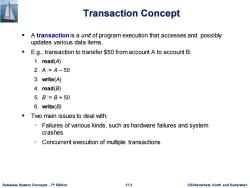
Transaction Concept A transaction is a unit of program execution that accesses and possibly updates various data items. E.g.,transaction to transfer $50 from account A to account B: 1.read(A) 2.A:=A-50 3.write(A) 4.read(B) 5.B:=B+50 6.write(B) Two main issues to deal with: Failures of various kinds,such as hardware failures and system crashes Concurrent execution of multiple transactions Database System Concepts-7th Edition 17.3 ©Silberscha乜,Korth and Sudarshan
Database System Concepts - 7 17.3 ©Silberschatz, Korth and Sudarshan th Edition Transaction Concept ▪ A transaction is a unit of program execution that accesses and possibly updates various data items. ▪ E.g., transaction to transfer $50 from account A to account B: 1. read(A) 2. A := A – 50 3. write(A) 4. read(B) 5. B := B + 50 6. write(B) ▪ Two main issues to deal with: • Failures of various kinds, such as hardware failures and system crashes • Concurrent execution of multiple transactions
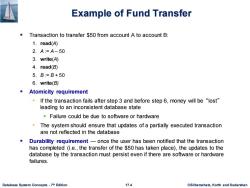
Example of Fund Transfer Transaction to transfer $50 from account A to account B: 1.read(A) 2.A=A-50 3.write(A) 4.read(B) 5.B:=B+50 6.write(B) Atomicity requirement If the transaction fails after step 3 and before step 6,money will be "lost" leading to an inconsistent database state Failure could be due to software or hardware The system should ensure that updates of a partially executed transaction are not reflected in the database Durability requirement-once the user has been notified that the transaction has completed (i.e.,the transfer of the $50 has taken place),the updates to the database by the transaction must persist even if there are software or hardware failures. Database System Concepts-7th Edition 17.4 ©Silberscha乜,Korth and Sudarshan
Database System Concepts - 7 17.4 ©Silberschatz, Korth and Sudarshan th Edition Example of Fund Transfer ▪ Transaction to transfer $50 from account A to account B: 1. read(A) 2. A := A – 50 3. write(A) 4. read(B) 5. B := B + 50 6. write(B) ▪ Atomicity requirement • If the transaction fails after step 3 and before step 6, money will be “lost” leading to an inconsistent database state ▪ Failure could be due to software or hardware • The system should ensure that updates of a partially executed transaction are not reflected in the database ▪ Durability requirement — once the user has been notified that the transaction has completed (i.e., the transfer of the $50 has taken place), the updates to the database by the transaction must persist even if there are software or hardware failures
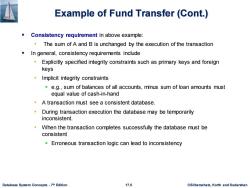
Example of Fund Transfer (Cont.) Consistency requirement in above example: The sum of A and B is unchanged by the execution of the transaction In general,consistency requirements include Explicitly specified integrity constraints such as primary keys and foreign keys Implicit integrity constraints e.g.,sum of balances of all accounts,minus sum of loan amounts must equal value of cash-in-hand A transaction must see a consistent database. During transaction execution the database may be temporarily inconsistent. When the transaction completes successfully the database must be consistent Erroneous transaction logic can lead to inconsistency Database System Concepts-7th Edition 17.5 ©Silberscha乜,Korth and Sudarshan
Database System Concepts - 7 17.5 ©Silberschatz, Korth and Sudarshan th Edition Example of Fund Transfer (Cont.) ▪ Consistency requirement in above example: • The sum of A and B is unchanged by the execution of the transaction ▪ In general, consistency requirements include • Explicitly specified integrity constraints such as primary keys and foreign keys • Implicit integrity constraints ▪ e.g., sum of balances of all accounts, minus sum of loan amounts must equal value of cash-in-hand • A transaction must see a consistent database. • During transaction execution the database may be temporarily inconsistent. • When the transaction completes successfully the database must be consistent ▪ Erroneous transaction logic can lead to inconsistency
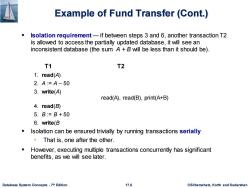
Example of Fund Transfer (Cont.) Isolation requirement-if between steps 3 and 6,another transaction T2 is allowed to access the partially updated database,it will see an inconsistent database(the sum A +B will be less than it should be). T1 T2 1.read(A) 2.A:=A-50 3.write(A) read(A),read(B),print(A+B) 4.read(B) 5.B:=B+50 6.write(B Isolation can be ensured trivially by running transactions serially That is,one after the other. However,executing multiple transactions concurrently has significant benefits,as we will see later. Database System Concepts-7th Edition 17.6 @Silberschatz,Korth and Sudarshan
Database System Concepts - 7 17.6 ©Silberschatz, Korth and Sudarshan th Edition Example of Fund Transfer (Cont.) ▪ Isolation requirement — if between steps 3 and 6, another transaction T2 is allowed to access the partially updated database, it will see an inconsistent database (the sum A + B will be less than it should be). T1 T2 1. read(A) 2. A := A – 50 3. write(A) read(A), read(B), print(A+B) 4. read(B) 5. B := B + 50 6. write(B ▪ Isolation can be ensured trivially by running transactions serially • That is, one after the other. ▪ However, executing multiple transactions concurrently has significant benefits, as we will see later
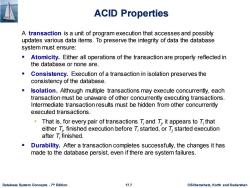
ACID Properties A transaction is a unit of program execution that accesses and possibly updates various data items.To preserve the integrity of data the database system must ensure: Atomicity.Either all operations of the transaction are properly reflected in the database or none are. Consistency.Execution of a transaction in isolation preserves the consistency of the database. Isolation.Although multiple transactions may execute concurrently,each transaction must be unaware of other concurrently executing transactions. Intermediate transaction results must be hidden from other concurrently executed transactions. That is,for every pair of transactions T;and Ti,it appears to T;that either Ti,finished execution before T;started,or T;started execution after 7;finished. ■ Durability.After a transaction completes successfully,the changes it has made to the database persist,even if there are system failures. Database System Concepts-7th Edition 17.7 @Silberschatz,Korth and Sudarshan
Database System Concepts - 7 17.7 ©Silberschatz, Korth and Sudarshan th Edition ACID Properties ▪ Atomicity. Either all operations of the transaction are properly reflected in the database or none are. ▪ Consistency. Execution of a transaction in isolation preserves the consistency of the database. ▪ Isolation. Although multiple transactions may execute concurrently, each transaction must be unaware of other concurrently executing transactions. Intermediate transaction results must be hidden from other concurrently executed transactions. • That is, for every pair of transactions Ti and Tj , it appears to Ti that either Tj , finished execution before Ti started, or Tj started execution after Ti finished. ▪ Durability. After a transaction completes successfully, the changes it has made to the database persist, even if there are system failures. A transaction is a unit of program execution that accesses and possibly updates various data items. To preserve the integrity of data the database system must ensure:

Transaction State Active-the initial state;the transaction stays in this state while it is executing Partially committed-after the final statement has been executed. Failed--after the discovery that normal execution can no longer proceed. Aborted-after the transaction has been rolled back and the database restored to its state prior to the start of the transaction.Two options after it has been aborted: Restart the transaction Can be done only if no internal logical error ·Kill the transaction Committed-after successful completion. Database System Concepts-7th Edition 17.8 ©Silberscha乜,Korth and Sudarshan
Database System Concepts - 7 17.8 ©Silberschatz, Korth and Sudarshan th Edition Transaction State ▪ Active – the initial state; the transaction stays in this state while it is executing ▪ Partially committed – after the final statement has been executed. ▪ Failed -- after the discovery that normal execution can no longer proceed. ▪ Aborted – after the transaction has been rolled back and the database restored to its state prior to the start of the transaction. Two options after it has been aborted: • Restart the transaction ▪ Can be done only if no internal logical error • Kill the transaction ▪ Committed – after successful completion

Transaction State (Cont.) partially committed committed active failed aborted Database System Concepts-7th Edition 17.9 @Silberschatz,Korth and Sudarshan
Database System Concepts - 7 17.9 ©Silberschatz, Korth and Sudarshan th Edition Transaction State (Cont.)

Concurrent Executions Multiple transactions are allowed to run concurrently in the system. Advantages are: Increased processor and disk utilization,leading to better transaction throughput B E.g.,one transaction can be using the CPU while another is reading from or writing to the disk Reduced average response time for transactions:short transactions need not wait behind long ones. Concurrency control schemes-mechanisms to achieve isolation That is,to control the interaction among the concurrent transactions in order to prevent them from destroying the consistency of the database Will study in Chapter 15,after studying notion of correctness of concurrent executions. Database System Concepts-7th Edition 17.10 ©Silberscha乜,Korth and Sudarshan
Database System Concepts - 7 17.10 ©Silberschatz, Korth and Sudarshan th Edition Concurrent Executions ▪ Multiple transactions are allowed to run concurrently in the system. Advantages are: • Increased processor and disk utilization, leading to better transaction throughput ▪ E.g., one transaction can be using the CPU while another is reading from or writing to the disk • Reduced average response time for transactions: short transactions need not wait behind long ones. ▪ Concurrency control schemes – mechanisms to achieve isolation • That is, to control the interaction among the concurrent transactions in order to prevent them from destroying the consistency of the database ▪ Will study in Chapter 15, after studying notion of correctness of concurrent executions

Schedules Schedule-a sequences of instructions that specify the chronological order in which instructions of concurrent transactions are executed A schedule for a set of transactions must consist of all instructions of those transactions Must preserve the order in which the instructions appear in each individual transaction. A transaction that successfully completes its execution will have a commit instructions as the last statement By default transaction assumed to execute commit instruction as its last step A transaction that fails to successfully complete its execution will have an abort instruction as the last statement Database System Concepts-7th Edition 17.11 ©Silberscha乜,Korth and Sudarshan
Database System Concepts - 7 17.11 ©Silberschatz, Korth and Sudarshan th Edition Schedules ▪ Schedule – a sequences of instructions that specify the chronological order in which instructions of concurrent transactions are executed • A schedule for a set of transactions must consist of all instructions of those transactions • Must preserve the order in which the instructions appear in each individual transaction. ▪ A transaction that successfully completes its execution will have a commit instructions as the last statement • By default transaction assumed to execute commit instruction as its last step ▪ A transaction that fails to successfully complete its execution will have an abort instruction as the last statement
按次数下载不扣除下载券;
注册用户24小时内重复下载只扣除一次;
顺序:VIP每日次数-->可用次数-->下载券;
- 《数据库系统概念 Database System Concepts》原书教学资源(第七版,PPT课件讲稿,英文版)Chapter 16 Query Optimization.pptx
- 《数据库系统概念 Database System Concepts》原书教学资源(第七版,PPT课件讲稿,英文版)Chapter 15 Query Processing.pptx
- 《数据库系统概念 Database System Concepts》原书教学资源(第七版,PPT课件讲稿,英文版)Chapter 14 Indexing.pptx
- 《数据库系统概念 Database System Concepts》原书教学资源(第七版,PPT课件讲稿,英文版)Chapter 13 Data Storage Structures.pptx
- 《数据库系统概念 Database System Concepts》原书教学资源(第七版,PPT课件讲稿,英文版)Chapter 12 Physical Storage Systems.pptx
- 《数据库系统概念 Database System Concepts》原书教学资源(第七版,PPT课件讲稿,英文版)Chapter 11 Data Analytics.pptx
- 《数据库系统概念 Database System Concepts》原书教学资源(第七版,PPT课件讲稿,英文版)Chapter 10 Big Data.pptx
- 《数据库系统概念 Database System Concepts》原书教学资源(第七版,PPT课件讲稿,英文版)Chapter 01 Introduction(Avi Silberschatz Henry F. Korth S. Sudarshan).pptx
- 《数据库系统概念 Database System Concepts》原书教学资源(第五版,PPT课件讲稿,英文版)Chapter 9 Object-Based Databases.ppt
- 《数据库系统概念 Database System Concepts》原书教学资源(第五版,PPT课件讲稿,英文版)Chapter 8 Application Design and Development.ppt
- 《数据库系统概念 Database System Concepts》原书教学资源(第五版,PPT课件讲稿,英文版)Chapter 7 Relational Database Design.ppt
- 《数据库系统概念 Database System Concepts》原书教学资源(第五版,PPT课件讲稿,英文版)Chapter 6 Entity-Relationship Model.ppt
- 《数据库系统概念 Database System Concepts》原书教学资源(第五版,PPT课件讲稿,英文版)Chapter 5 Other Relational Languages.ppt
- 《数据库系统概念 Database System Concepts》原书教学资源(第五版,PPT课件讲稿,英文版)Chapter 4 Advanced SQL.ppt
- 《数据库系统概念 Database System Concepts》原书教学资源(第五版,PPT课件讲稿,英文版)Chapter 3 SQL.ppt
- 《数据库系统概念 Database System Concepts》原书教学资源(第五版,PPT课件讲稿,英文版)Chapter Advanced Transaction Processing.ppt
- 《数据库系统概念 Database System Concepts》原书教学资源(第五版,PPT课件讲稿,英文版)Chapter 24 Advanced Data Types.ppt
- 《数据库系统概念 Database System Concepts》原书教学资源(第五版,PPT课件讲稿,英文版)Chapter 23 Advanced Application Development.ppt
- 《数据库系统概念 Database System Concepts》原书教学资源(第五版,PPT课件讲稿,英文版)Chapter 22 Distributed Databases.ppt
- 《数据库系统概念 Database System Concepts》原书教学资源(第五版,PPT课件讲稿,英文版)Chapter 21 Parallel Databases.ppt
- 《数据库系统概念 Database System Concepts》原书教学资源(第七版,PPT课件讲稿,英文版)Chapter 18 Concurrency Control.pptx
- 《数据库系统概念 Database System Concepts》原书教学资源(第七版,PPT课件讲稿,英文版)Chapter 19 Recovery System.pptx
- 《数据库系统概念 Database System Concepts》原书教学资源(第七版,PPT课件讲稿,英文版)Chapter 02 Intro to Relational Model.pptx
- 《数据库系统概念 Database System Concepts》原书教学资源(第七版,PPT课件讲稿,英文版)Chapter 20 Database System Architectures.pptx
- 《数据库系统概念 Database System Concepts》原书教学资源(第七版,PPT课件讲稿,英文版)Chapter 21 Parallel and Distributed Storage.pptx
- 《数据库系统概念 Database System Concepts》原书教学资源(第七版,PPT课件讲稿,英文版)Chapter 22 Parallel and Distributed Query Processing.pptx
- 《数据库系统概念 Database System Concepts》原书教学资源(第七版,PPT课件讲稿,英文版)Chapter 23 Parallel and Distributed Transaction Processing.pptx
- 《数据库系统概念 Database System Concepts》原书教学资源(第七版,PPT课件讲稿,英文版)Chapter 24 Advanced Indexing.pptx
- 《数据库系统概念 Database System Concepts》原书教学资源(第七版,PPT课件讲稿,英文版)Chapter 25 Advanced Application Development.pptx
- 《数据库系统概念 Database System Concepts》原书教学资源(第七版,PPT课件讲稿,英文版)Chapter 26 Blockchain Databases.pptx
- 《数据库系统概念 Database System Concepts》原书教学资源(第七版,PPT课件讲稿,英文版)Chapter 27 Formal-Relational Query Languages.pptx
- 《数据库系统概念 Database System Concepts》原书教学资源(第七版,PPT课件讲稿,英文版)Chapter 28 Advanced Relational Database Design.pptx
- 《数据库系统概念 Database System Concepts》原书教学资源(第七版,PPT课件讲稿,英文版)Chapter 29 Object-Based Databases.pptx
- 《数据库系统概念 Database System Concepts》原书教学资源(第七版,PPT课件讲稿,英文版)Chapter 03 Introduction to SQL.pptx
- 《数据库系统概念 Database System Concepts》原书教学资源(第七版,PPT课件讲稿,英文版)Chapter 30 XML.pptx
- 《数据库系统概念 Database System Concepts》原书教学资源(第七版,PPT课件讲稿,英文版)Chapter 31 Information Retrieval.pptx
- 《数据库系统概念 Database System Concepts》原书教学资源(第七版,PPT课件讲稿,英文版)Chapter 04 Intermediate SQL.pptx
- 《数据库系统概念 Database System Concepts》原书教学资源(第七版,PPT课件讲稿,英文版)Chapter 05 Advanced SQL.pptx
- 《数据库系统概念 Database System Concepts》原书教学资源(第七版,PPT课件讲稿,英文版)Chapter 06 Database Design Using the E-R Model.pptx
- 《数据库系统概念 Database System Concepts》原书教学资源(第七版,PPT课件讲稿,英文版)Chapter 07 Normalization.pptx
